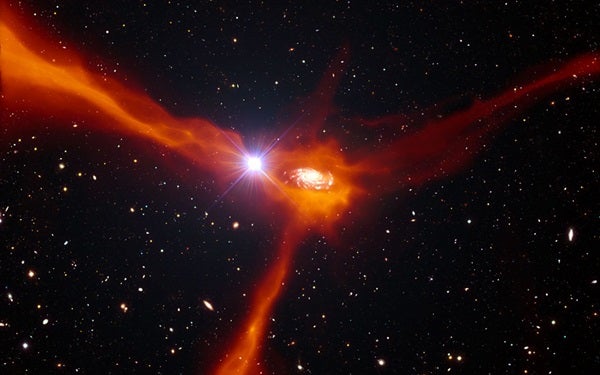Astronomers have always suspected that galaxies grow by pulling in material from their surroundings, but this process has proved difficult to observe directly. Now ESO’s VLT has been used to study a very rare alignment between a distant galaxy and an even more distant quasar — the extremely bright center of a galaxy powered by a supermassive black hole. The light from the quasar passes through the material around the foreground galaxy before reaching Earth, making it possible to explore in detail the properties of the gas around the galaxy. These new results give the best view so far of a galaxy in the act of feeding.
“This kind of alignment is very rare and it has allowed us to make unique observations,” explained lead author Nicolas Bouché of the Research Institute in Astrophysics and Planetology in Toulouse, France. “We were able to use ESO’s Very Large Telescope to peer at both the galaxy itself and its surrounding gas. This meant we could attack an important problem in galaxy formation: How do galaxies grow and feed star formation?”
Galaxies quickly deplete their reservoirs of gas as they create new stars and so must somehow be continuously replenished with fresh gas to keep going. Astronomers suspected that the answer to this problem lay in the collection of cool gas from the surroundings by the gravitational pull of the galaxy. In this scenario, a galaxy drags gas inward, which then circles around the galaxy, rotating with it before falling in. Although some evidence of such accretion had been observed in galaxies before, the motion of the gas and its other properties had not been fully explored up to now.
The astronomers used two instruments, the Spectrograph for INtegral Field Observations in the Near Infrared (SINFONI) and the Ultraviolet and Visual Echelle Spectrograph (UVES), both of which are mounted on ESO’s VLT at the Paranal Observatory in northern Chile. The new observations showed both how the galaxy itself was rotating and revealed the composition and motion of the gas outside the galaxy.
“The properties of this vast volume of surrounding gas were exactly what we would expect to find if the cold gas was being pulled in by the galaxy,” said co-author Michael Murphy of Swinburne University of Technology in Australia. “The gas is moving as expected, there is about the expected amount, and it also has the right composition to fit the models perfectly. It’s like feeding time for lions at the zoo — this particular galaxy has a voracious appetite, and we’ve discovered how it feeds itself to grow so quickly.”
Astronomers have already found evidence of material around galaxies in the early universe, but this is the first time that they have been able to show clearly that the material is moving inward rather than outward and also to determine the composition of this fresh fuel for future generations of stars. Without the quasar’s light to act as a probe, this surrounding gas would be undetectable.
“In this case, we were lucky that the quasar happened to be in just the right place for its light to pass through the infalling gas. The next generation of extremely large telescopes will enable studies with multiple sight lines per galaxy and provide a much more complete view,” concluded co-author Crystal Martin of University of California, Santa Barbara.










